September 2, 2022
Air Date: September 2, 2022
FULL SHOW
SEGMENTS
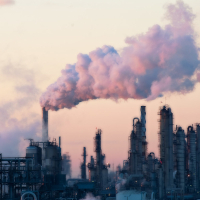
Mapping Cancer-Causing Air
/ Lisa SongView the page for this story
Millions of Americans are breathing toxic air pollution emitted from industrial facilities, often without their knowledge. The nonprofit investigative newsroom ProPublica created an interactive map that highlights the EPA’s failure to account for the cumulative cancer risk for Americans who live near several industrial facilities. Lisa Song is a climate and energy reporter with ProPublica and discusses the team’s findings with Host Bobby Bascomb. (12:14)
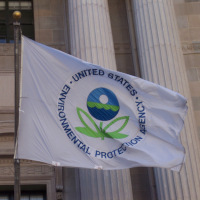
Whistleblowers Say EPA Endangers Public Health
View the page for this story
Five whistleblowers have exposed toxic working conditions within the EPA’s New Chemicals Division. In their disclosure, they describe how scientists are forced to erase findings about cancer risk and other types of toxicity from safety reports and point to a huge revolving door between the EPA and the chemical industry. They also say the agency is only slowly assessing some 80,000 legacy chemicals within daily household products like paint and pesticides that potentially contain hazards to human health and the environment. Host Steve Curwood is joined by Kyla Bennett, the director of science policy at Public Employees for Environmental Responsibility and a lawyer who works with the whistleblowers. (14:38)

BirdNote®: Skylark – With Aretha Franklin
/ Mary McCannView the page for this story
The skylark is the only bird in North America that sings for three minutes straight while in flight. Aretha Franklin’s soulful rendition of “Skylark” accompanies the bird’s airborne song in this piece from BirdNote’s Mary McCann. (02:15)
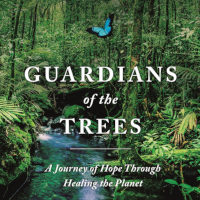
Guardians of the Trees
View the page for this story
Indonesian Borneo is home to Gunung Palung National Park, which hosts diverse species found nowhere else and is beloved by the people who live on the island. But like many people who live near tropical forests, they have at times had to resort to illegal logging to pay for healthcare. To combat this, physician Kinari Webb founded the nonprofit Health in Harmony, which aims to keep the forest healthy by keeping people healthy. Dr. Webb writes about this in her memoir Guardians of the Trees: A Journey of Hope Through Healing the Planet, which she spoke about with Hosts Steve Curwood and Bobby Bascomb at a Living on Earth Book Club event. (18:38)
Show Credits and Funders
Show Transcript
HOSTS: Steve Curwood, Bobby Bascomb
GUESTS: Lisa Song, Kyla Bennett, Kinari Webb
REPORTERS: Mary McCann
CURWOOD: From PRX this is Living on Earth
[THEME]
CURWOOD: From PRX his is living on Earth, I’m Steve Curwood
BASCOMB: And I’m Bobby Bascomb
Whistleblowers at the EPA say they have been forced to delete cancer warnings about new chemicals.
BENNET: The scientists who are responsible for figuring out weather new chemicals pose risk to human health or the environment they’re being instructed to delete hazards from these risk assessments to make chemicals appear safer than they are.
CURWOOD: Also, flaws in the way EPA calculates cancer risk.
SONG: If you live near two refineries, they will look at the risk from both of those refineries together. But if you live next to a refinery and a chemical plant, then the EPA is not going to be looking at the total risk from both of those, because they're considered two different types of facilities.
CURWOOD: That and more this week on Living on Earth – Stick Around!
[NEWSBREAK MUSIC: Boards Of Canada “Zoetrope” from “In A Beautiful Place Out In The Country” (Warp Records 2000)]
[THEME]
Mapping Cancer-Causing Air
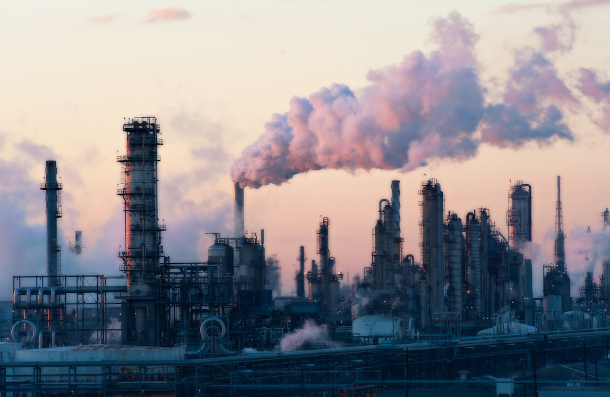
A refinery in Houston, Texas, where the petrochemical industry sends significant amounts of carcinogenic compounds into the air, raising the risk of developing cancer. (Photo: Louis Vest, Flickr CC BY-NC 2.0)
CURWOOD: From PRX and the Jennifer and Ted Stanley studios at the University of Massachusetts, Boston this is an encore edition of Living on Earth, I’m Steve Curwood.
BASCOMB: And I’m Bobby Bascomb.
In some neighborhoods located near industrial areas, air pollution far exceeds levels considered acceptable by the Environmental Protection Agency. Those air pollutants include carcinogens like benzene, ethylene oxide, and heavy metals like chromium, cobalt, and nickel. And until now if you wanted to know about the extra cancer risk you could face from living near these sources you were out of luck. But now in a first-of-its-kind map and data analysis the nonprofit investigative newsroom ProPublica has yielded new insights into how multiple sources of industrial carcinogens can add up to elevated cancer risk for local neighborhoods. Lisa Song is a climate and energy reporter at ProPublica and part of the team that put together the analysis. She’s also a former Living on Earth intern and joins me now from New York City. Welcome back to Living on Earth, Lisa!
SONG: Thanks for having me.
BASCOMB: So what's new about this mapping tool? What are you trying to show here?
SONG: What we're trying to show is the cumulative industrial cancer risk from major sources of toxic air pollution. And this is important because the way the EPA normally assesses industrial cancer risk is they do it for one type of facility at a time. And so that often underestimates the estimated cancer risk because so many people are living in close proximity to several different industrial facilities at once.
BASCOMB: And so how can you use this, as a user, if you go to the ProPublica site, how can a person use this information that you've put together?
SONG: So we put this data together into a searchable map, so you can type in your home address or your work address, and it will zoom in to your exact place and show you at a very localized level the estimated additional cancer risk from these big industrial facilities in your area. And if you live in one of those places where you don't have a facility nearby, it will tell you that, you know, the nearest facility is six miles away, or 10 miles away, or whatever the number is. You can also just put in the name of a town or a city. And it will give you a kind of city wide overview to say, you know, this area with a population of roughly this many people, you know, the largest estimated cancer risk in this area is x and the average is y, something like that.
BASCOMB: And so just to be clear, this is EPA's data and it's going into your database.
SONG: Yes, the raw data from this comes from the EPA. And what they've done over the years is they take the annual data that the industries report to EPA about how many pounds of benzene or how many pounds of chromium they emit into the air every year. And then the EPA runs its own air model on these emissions, to model out where the emissions are going, kind of, where they go geographically and the concentrations at places on the map. And so all of this raw data has been in EPA's possession for, for many years. And what ProPublica did is we analyzed it and put it together in a way to make it searchable and usable and practical for the public.
BASCOMB: And so you identified more than a thousand hotspots around the country where industrial sources emit carcinogenic air pollution. Where are they generally located?
SONG: Most of these hotspots are in southern states. So the top hotspot on our map is what's known as Cancer Alley in a part of Louisiana. And then other top hotspots are, there's one near Houston, and then there's one in Orange, Texas,
BASCOMB: This is the same area where they're looking to expand, and we've covered some stories in the past on the show about ethane crackers and looking to site new ethane cracking facilities in the same area where people already have an elevated health risk associated with industry. And EPA knows about it, it almost seems like these are just kind of sacrifice zones.
SONG: Yeah, and that, that is the term we and others have used to describe these areas. And it's important to remember that this is simply how our regulatory system is set up. It was not set up to adequately account for cumulative risks. The way the EPA assesses risk, you know, they're slicing and dicing the risk in a way that, for example, if you live near two refineries, they will look at the risk from both of those refineries together. But if you live next to a refinery and a chemical plant, then EPA is not going to be looking at the total risk from both of those facilities, because they're considered two different types of facilities. So that oversight is baked into the way that the EPA does its regulations right now. And when we spoke with EPA officials, they did say that the Biden administration plans to take a look at this and perhaps have a new approach. But that's something that's going to take time. So right now, you know, we have not seen that concrete action yet.
BASCOMB: Well, let's talk about one of the people that was featured in your article. Tell me about Brittany Madison, please.

(Left) Baytown resident Brittany Madison gives her 3-year-old niece, K’ryah, an asthma treatment, which K’ryah takes twice a day. (Right) The ExxonMobil Baytown complex is seen from Oklahoma Street in Baytown. (Photo: Kathleen Flynn for ProPublica)
SONG: Sure. Brittany lives in Baytown, which is near Houston, and she lives with her family. And they live next to many, many different industrial facilities. So Brittany's apartment is within 30 miles of more than 170 facilities that give off toxic emissions. And we looked at the three facilities that account for most of the risk on her block. Those facilities include an ExxonMobil refinery and then two other large facilities. So if you look at the risk of each of these facilities in isolation, the risk is relatively low. So the refinery, for example, increases the estimated risk of getting cancer on her block by about 1 in 730,000. And then, you know, the two other facilities are somewhere in the range of 1 in 100 [thousand] or 200,000. But then when you add up the combined risk from all three facilities, plus all the other facilities in the area, the estimated additional cancer risk jumps to 1 in 46,000. So you can see how quickly these combined risks add up together. And when we spoke with Brittany, she talked about how her niece, who's only three years old, has asthma and needs asthma treatments, how she and her family have suffered from headaches and migraines and other ailments, particularly after an industrial accident at the refinery a couple of years ago. She's had family members who have died of cancer, she's had family members who have worked for the industrial sector. And one thing to keep in mind about our map in our reporting is it's very difficult to prove that a particular person's cancer was caused by a particular type of pollution. But we do know that these air pollution risks compound cancer risk overall.
BASCOMB: I believe you said her cancer risk, when you overlay all of these these hazards, is 1 in 46,000. What is the EPA threshold, if there is one for concern? I mean, at what point is there some sort of intervention, even?
SONG: So the EPA, their main general threshold for cancer risk is 1 in 10,000. But they also don't use 1 in 10,000 as an absolute cutoff point. At the same time, the EPA actually has an aspirational goal of minimizing the number of Americans exposed to industrial risk higher than 1 in a million. So certainly by the 1 in a million standard, the place where Madison lives, that cancer risk is much, much higher than the 1 in a million goal. But it is lower than the 1 in 10,000 that EPA typically considers an upper limit.
BASCOMB: And I believe you even drill down further into the US population as a whole to see where we lie in the spectrum of cancer risk. What did you find there?
SONG: Well, in terms of the EPA's aspirational standard, we found that 74 million Americans live in places where the estimated risk is greater than 1 in a million. And that's something like a fifth of the US population. If you're looking at places with higher than 1 in 10,000 risk, which the EPA generally uses as an upper limit, then about a quarter million people live in those places. You've got places like Cancer Alley, certain parts of Texas, but also other states as well. There's a lot of smaller pockets of hotspots in places that maybe the residents don't even know they're living there.

Brittany Madison walks her nieces and nephew to the apartment they share with her sister in Baytown, Texas. (Photo: Kathleen Flynn for ProPublica)
BASCOMB: And Brittany Madison is African American, and we know that communities of color tend to bear out more pollution burden than predominantly white communities. To what extent were you able to quantify that risk for black communities using this mapping tool?
SONG: Yeah, so our national analysis showed that in census tracts that are mostly people of color, they experience about 40% more pollution than census tracts that are mostly white residents. And in mostly black census tracts, they're being exposed to more than double these pollutants than predominantly white census tracts. So it really is something that confirms the decades of research that have shown how pollution is segregated, and pollution is concentrated in communities of color.
BASCOMB: You know, how do you hope the public will use this tool that you've come up with?
SONG: I think the first thing is we just want the public to be aware and to you know, search for their own homes, to search for their friends' and families' homes and see, are you living in an area that is a hotspot? And if so, we've actually published a guide for residents in hotspots that explains to them, what are the types of things that community groups in other hotspots have done historically? The guide, we hope, will perhaps give them more context to our findings and help alleviate certain anxieties. The guide also explains that very organized communities in Cancer Alley, for example, they have done things like campaign for regular air monitoring. They've looked for funding to conduct their own independent air monitoring. Some communities have done things like worked with the facilities so that they're all notified whenever the facility has some kind of unexpected accident. Other people have purchased air filters to use inside their homes to make the air a little bit safer indoors, and other communities even have worked with lawyers and filed lawsuits. So there's really a whole bunch of things that these types of communities have done historically. And we're hoping that our guide can just help inform and perhaps empower people who are discovering they're in hotspots for the first time.
BASCOMB: Lisa Song is a climate and energy reporter for ProPublica. Lisa, thank you so much for this wonderful tool and for chatting with me today.
SONG: Thanks.
BASCOMB: We reached out to EPA to ask about potential plans to change the way they assess cumulative risk from industrial exposure.
They responded in part: EPA is committed to making significant and urgent progress in addressing the unfair or disproportionate burdens of environmental health risks which includes understanding and responding to issues of cumulative impacts and cumulative risks related to multiple sources. To see the full EPA statement visit the Living on Earth Website, LOE dot org.
Related links:
- ProPublica | “Poison in the Air”
- ProPublica | “The EPA Administrator Visited Cancer-Causing Air Pollution Hot Spots Highlighted by ProPublica and Promised Reforms”
- EPA | “Full EPA Statement on Addressing Cumulative Cancer Risk”
[MUSIC: Sam Gendel and Sam Wilkes, “Boa” on Music for Saxofone and Bass Guitar, by Sam Gendel and Sam Wilkes, Leaving Records]
CURWOOD: Coming up – Whistleblowers at the EPA say the agency has a revolving door with industry and doesn’t adequately protect public health. That’s just ahead on Living on Earth.
ANNOUNCER: Support for Living on Earth comes from Sailors for the Sea and Oceana. Helping boaters race clean, sail green, and protect the seas they love. More information @sailorsforthesea.org. Support also comes from Friends of Smeagull the Seagull and Smeagull’s Guide to Wildlife. It’s all about the wildlife right next door to you! That’s Smeagull, S - M - E - A - G - U - L - L, SmeagullGuide.org.
[MUSIC: Mongo Santamaria, “Dawn’s Light” on Brazilian Sunset, by Mongo Santamaria, Candid Records]
Whistleblowers Say EPA Endangers Public Health
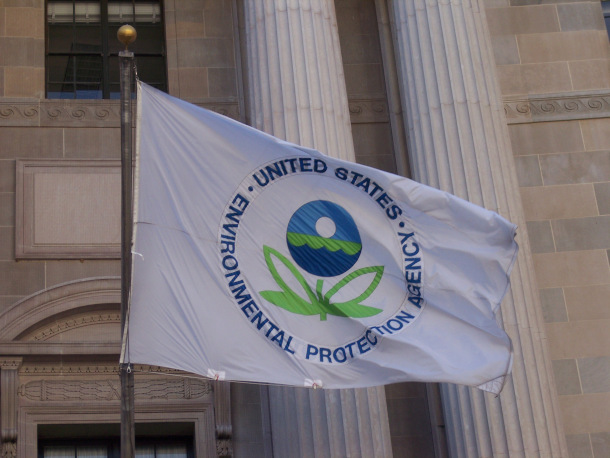
The EPA, according to Bennett, has done virtually nothing to regulate PFAS (forever chemicals) and since 2017 has not rejected any of the applications for the hundreds of new, potentially harmful chemicals being produced every year. She and other members at PEER joke that the EPA should stand for “Everything’s Polluted Anyways.” (Photo: Paul A. Fagan, Flickr, CC BY-NC-ND 2.0)
BASCOMB: It’s Living on Earth, I’m Bobby Bascomb
CURWOOD: And I’m Steve Curwood
Five whistleblowers allege the New Chemicals division of the Environmental Protection Agency bends over backwards for industry and has even deleted cancer risk findings for chemicals it has approved for public use. They claim this culture of deference to industry has allowed thousands of new and possibly dangerous chemicals on to the market and assert since 2017 the EPA has not rejected a single new chemical application. The whistleblowers say a revolving door between industry and the EPA creates a toxic work environment for career scientists who fear they may be forced to approve unsafe chemicals. For more, I’m joined now by Kyla Bennett, who represents the EPA whistleblowers. She’s a lawyer at Public Employees for Environmental Responsibility, Welcome to Living on Earth!
BENNETT: Thank you so much for having me.
CURWOOD: What's going on right now, in terms of being a little too cozy with industry in the EPA's new chemicals division?
BENNETT: The scientists who are responsible for figuring out whether new chemicals pose risk to human health or the environment, they are being instructed to delete hazards from these risk assessments to make chemicals appear safer than they are, you know, where it says this is a carcinogen. It's crossed out, redlined out. Some of our clients have said, I refuse to have my name on that so-called science. And so management says, "okay, we'll have somebody else post it." In my mind, it's malfeasance.
CURWOOD: So how much danger health-wise does the American public face?
BENNETT: An incredible amount of danger. I mean, if you look at EPA's own data since 2016, they have prevented zero chemicals from going on the market. In other words, everything that comes before them, either gets approved, or not very often, withdrawn by the submitter. All of these chemicals going out, and we're talking about hundreds a year, are not being assessed properly. There's something like 80,000 chemicals out there are currently in commerce. The vast majority of those have never had risk assessments done. Because the statute TSCA that requires this risk assessment to be done came into being in 1976 that automatically grandfathered in all the chemicals that were already on the market. 10 chemicals a year they reassess these old chemicals to see if they're dangerous or not.
CURWOOD: That will take I guess, what 100 years,150 years to go through?
BENNETT: 7000 years.
CURWOOD: Oh, sorry. 7000 years it will take.
BENNETT: So the majority of chemicals that are out on the shelves of Target and Walmart and Home Depot and Lowe's, we have no idea what most of those do to us.
CURWOOD: How long have these transgressions been going on within the EPA?
BENNETT: A lot of people want to blame it on the Trump administration, and indeed it did get worse under the Trump administration. He brought in industry people to run the agency. Under the Biden administration, it's still occurring. We have audio recordings of some of these managers. They said, we just want a button we can press to override all the science. They have a category of cases called hair on fire cases. So anytime an industry or a congressional calls EPA and says, Why is it taking so long, it becomes a hair on fire case, and management takes it and gets it out faster. This is not the way this is supposed to work.
CURWOOD: How much pushback and work pressure are the whistleblowers at the EPA currently under? I mean, how much do they stand to lose?
BENNETT: One thing people don't understand is that these clients of ours become whistleblowers as a last ditch effort. So our five clients at EPA, they did try to use the administrative processes, for example, the scientific integrity policy, they tried going to their managers, they tried filing complaints, internally, nothing happened. So they felt like they were caught between a rock and a hard place. And they stand to lose their careers, their credibility, they’re pariahs to a certain extent. They're all facing incredible retaliation. And sometimes I jokingly say to my boss, I feel like I'm 1/3 scientist, 1/3 lawyer and 1/3 therapist. And they've come forward not for personal gain. But because they are so concerned about what these chemicals are doing to people's health and the environment.
CURWOOD: The journalism organization, The Intercept has been writing a series of articles about the whistleblowers, and one characteristic of their reporting is what looks like a revolving door between industry and the people who decide whether or not it is safe for the public to be exposed to chemicals. To what extent do you see a revolving door?

Chemists at the EPA say they have been forced to erase findings on the toxicity of certain chemicals. This is a stock photo of a laboratory, not an EPA lab. (Photo: PEO ACWA, Flickr, CC BY 2.0)
BENNETT: I first have to say that The Intercept has done an amazing job. We didn't know who we could bring the story to, because it's very, very difficult and dense science. And I think Sharon Lerner has done an amazing job. And what you say is correct. There's one fellow who has been back and forth between EPA and industry, I think four times now. Of the past nine directors of the Office of Pesticides, seven of them currently work in industry, and the other two just retired. It's kind of a unspoken thing where you work for EPA, and then you'll get a job at industry so you can show them how to get through all those loopholes and get what you want. It's despicable.
CURWOOD: Now, the articles in The Intercept mentioned that the whistleblower report has been leaked to the staff members named in such a whistleblower report. How much does that compromise investigation? How unusual is that?
BENNETT: What happened is in order for the whistleblowers to get protection under the Whistleblower Protection Act, somebody in their management chain has to know that they are the whistleblowers. Because otherwise they could get retaliated against. And the managers could say, oh, I had no idea it was you who was the whistleblower. So in this instance, we sent the disclosure to Dr. Michal Freedhoff, who's the Assistant Administrator, the political appointee for the Office of Chemical Safety and Pollution Prevention. And within three minutes, she sent it to one of the people named in it, and that person then said, please send it to everybody who's named in this complaint, and they actually held a meeting, presumably to figure out how they were going to protect themselves. Does that compromise the IG's investigation? Yes, I think so. It was very disturbing and very unusual to have this happen.
CURWOOD: Now, to what extent are the transgressions you're talking about at the EPA attributable to burnout, understaffing versus just pure negligence or maybe even some more pernicious motives?
BENNETT: It is absolutely true that EPA is under resourced. Dr. Freedhoff has been begging Congress for more money. She claims that this particular division needs at least twice as much money. I agree with her. They're not getting it, by the way from Congress. So that's definitely part of it. But it goes deeper than that. You know, most people when they think about doing risk assessments on chemicals, they probably visualize these people in these white lab coats and labs with, you know, test tubes and Erlenmeyer flasks. That's not what happens. They get the name of the chemical, and they get sometimes just an abstract of an industry sponsored study. And from that they have 90 days to figure out whether this chemical presents a risk or not. Now under the statute, TSCA, they are allowed to ask the submitters for more information, but EPA doesn't let them do that. So yes, resources and funding is definitely a part of it. But honestly, they are allowed to say no, and they are not saying no. And that's the bigger problem.
CURWOOD: Wait a second, the studies on these chemicals—those are studies conducted by the industry itself?
BENNETT: Absolutely. And that's a problem right there. Because as we all know, industry studies can be biased. They are providing their own scientists' studies saying we think this is safe, you've got 90 days EPA to tell us whether you agree or not. I mean, it's really scary. And what they often have to do is rely on an analog—it's a structurally similar chemical. And then they can say, well, this other very similar chemical causes cancer or is a mutagen. And therefore, we think that this new chemical might act the same way. But one of the more frightening things for me is part of tsca section 8(e) requires submitters of chemicals, if they come across information that leads them to believe that their chemical could be a substantial risk to human health or the environment. They have 30 days to send EPA that information. And EPA is supposed to post them on this public facing website called Chem view. And they haven't posted any since 2017. They've been coming in getting stacked up, and they claim they didn't have the resources to post them. In other countries, chemicals are guilty until proven innocent, and in the United States of America gosh, darn it, they're innocent until proven guilty. And they make it as hard as possible to prove them guilty.
CURWOOD: What's the workplace climate like at the EPA, in this division, where the folks are reviewing new chemicals?
BENNETT: I have never seen a division so demoralized, intimidated, unhappy and scared. One of the things EPA did do when we started bringing these issues to the public is they did a survey and the people in the division were saying that the division is toxic, that industry is running it. They're all afraid that they are gonna be responsible for the next PFAS that's killing people. They're all miserable. It's absolutely heartbreaking.
CURWOOD: How are managers or workers' performances measured within the EPA? I mean, what are the metrics and standards that they are held to?
BENNETT: EPA's bean counting seems to be based on how many chemicals do you get out on the market within that 90 day statutory timeframe? What I think it should be is how many chemicals that are dangerous did you prevent from getting out on market? I mean, we joke around that EPA should stand for everything's polluted anyway, instead of the Environmental Protection Agency.
CURWOOD: By the way, how does the EPA’s handling of these chemicals compare to some other international agencies?

Glyphosates and neonicotinoids are known carcinogens, yet are still approved for use by the EPA. (Photo: Scot Nelson, Flickr, Public Domain)
BENNETT: EPA, I think is one of the worst. Look at PFS as an example per-and polyfluoroalkyl substances. We have a national contamination crisis. Every one we look at as toxic, they call them forever chemicals because they don't go away. Even here in my little town in Massachusetts, I cannot drink my water because of how much PFAS we have. What has EPA done? Nothing. They have not banned any of them. They have a guideline on two of them. Europe is moving ahead with banning them as a class.
CURWOOD: What's your wild guess as to how many adverse health effects are in our population from the EPA's failure to appropriately regulate these chemicals?
BENNETT: Virtually every environmentally induced health effect that everybody has is from something that came across EPA's desk, everything, everything. Except for maybe skin cancer, they say something like 15% of cancers are from viruses, but the other 85%, they're from chemicals.
CURWOOD: So what kind of short term measures can people take? How can we know to protect ourselves?
BENNETT: The only thing that I tell people is to try to go as natural as possible. When my husband and I walk our dogs around the block, I can smell people's fabric softeners come out of the dryer vents. Those are carcinogens. These safety data sheets, which are supposed to inform workers or consumers don't have the information on them because of what EPA is doing. So basically, the short answer to your question is it's impossible to know.
CURWOOD: So how can communities act to pressure the Environmental Protection Agency?There’s a special class of communities are at risk. Those folks who live on the fence line of manufacturing facilities or low income minority communities that are already disproportionately exposed to toxins and emissions and don't have the health care options that many people do have? What can be done?
Whistleblowers expose corruption in EPA chemical safety office. https://t.co/mfCq1tdPuv
— The Intercept (@theintercept) July 4, 2021
BENNETT: You know, we're here to help. There are other environmental groups that are trying really hard to help. Environmental Working Group and Earth Justice. But if you look at, for example, Cape Fear in North Carolina, those community groups are fighting back really, really hard against the PFAS contamination in their towns. Flint, Michigan, they've got some great activists there, their water is still not safe to drink. And not only do they have lead, but they have PFAS as well. The only advice I can give them is to do Freedom of Information Act requests to EPA, push them, call your Congressionals, both state and federal. So many people think that because a Democrat is in office as President, that the EPA is okay. It is absolutely not the case.
CURWOOD: So what about the investigation into the EPA, what kind of changes are possible?
BENNETT: I have a lot of hope with the Inspector General. They are taking this very seriously. They have a team of people, they got confidential business information, CBI, cleared. They brought on board chemists and toxicologists to review the information that we've given them, but it's slow going, and we gave them so much information. I'm hoping that the investigations are finished sometime this calendar year. But the tricky part is that once the inspector general comes out with a report or reports, they don't have enforcement power, its recommendations to EPA. So what do we think EPA is gonna say? While we may be vindicated, is the problem going to get fixed? I honestly don't know.
CURWOOD: Kyler Bennett is Director of Science Policy for Public Employees For Environmental Responsibility. Thank you so much for taking the time with us today.
BENNETT: Thank you so much for having me. I really enjoyed it.
[BIRDNOTE THEME]
BASCOMB: The beautiful song of skylarks are a delight to many, including Aretha Franklin.
BirdNotes Mary McCann has more.
BirdNote®Skylark in Spring – with Aretha Franklin
Written by Chris Peterson
This is BirdNote!
[Aretha Franklin sings Skylark] Skylark...Have you anything to say to me…
Imagine – singing for three minutes while soaring to 100 feet in the air. The Skylark – no other bird in North America has such a long song or sings so persistently in flight.
*[Long sound break with song of the Skykark and continue under the text]
Around 1902, Skylarks were brought from England to Vancouver Island, British Columbia, to satisfy the desire of English immigrants to hear the birds' exalted song. This remains the only place in North America, except for a few sightings in Alaska, where the Skylark can be heard. [Pause] Never mind. They do what so many birds do – they carry our aspirations and send our spirits soaring.
Oh skylark
I don't know if you can find all of these things
But my heart is riding on your wings...
###
Song of the Skylark provided by The Macaulay Library at the Cornell Lab of Ornithology, Ithaca, New York. Recorded by A.B. Vandenberg.
Skylark written by Hoagy Carmichael and Johnny Mercer, 1941, Mercer Music/ Frank Music Corp (ASCAP). From the CD Aretha Franklin - Jazz to Soul, Sony, 1992
BirdNote's theme music was composed and played by Nancy Rumbel and produced by John Kessler.
Producer: John Kessler
Executive Producer: Chris Peterson
© 2015 Tune In to Nature.org May 2017/2020 Narrator: Mary McCann
ID# SKLAfranklina-2010-05-03-MM SKLAfranklina-01b
* Birds of North America, Issue No. 286, Authors: Campbell, R. W., L. M. Van Damme, and S. R. Johnson
BASCOMB: For photos flock on over to the Living on Earth website, loe dot org
Related links:
- Kyla Bennett’s website at PEER
- The Intercept’s series on the EPA Whistleblowers
[BIRDNOTE THEME]
BirdNote®: Skylark – With Aretha Franklin

The skylark sings its unusually long song while flying up to 100 feet above the ground. (Photo: caroline legg, Flickr, CC BY 2.0)
BASCOMB: The beautiful song of skylarks are a delight to many, including Aretha Franklin.
BirdNotes Mary McCann has more.
BirdNote®Skylark in Spring – with Aretha Franklin
Written by Chris Peterson
This is BirdNote!
[Aretha Franklin sings Skylark] Skylark...Have you anything to say to me…
Imagine – singing for three minutes while soaring to 100 feet in the air. The Skylark – no other bird in North America has such a long song or sings so persistently in flight.
*[Long sound break with song of the Skykark and continue under the text]
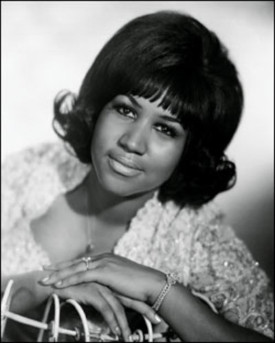
Aretha Franklin released her version of the jazz tune, “Skylark” in 1963. (Photo: Fred Seibert, Flickr, CC BY-NC-ND 2.0)
Around 1902, Skylarks were brought from England to Vancouver Island, British Columbia, to satisfy the desire of English immigrants to hear the birds' exalted song. This remains the only place in North America, except for a few sightings in Alaska, where the Skylark can be heard. [Pause] Never mind. They do what so many birds do – they carry our aspirations and send our spirits soaring.
Oh skylark
I don't know if you can find all of these things
But my heart is riding on your wings...
###
Song of the Skylark provided by The Macaulay Library at the Cornell Lab of Ornithology, Ithaca, New York. Recorded by A.B. Vandenberg.
Skylark written by Hoagy Carmichael and Johnny Mercer, 1941, Mercer Music/ Frank Music Corp (ASCAP). From the CD Aretha Franklin - Jazz to Soul, Sony, 1992
BirdNote's theme music was composed and played by Nancy Rumbel and produced by John Kessler.
Producer: John Kessler
Executive Producer: Chris Peterson
© 2015 Tune In to Nature.org May 2017/2020 Narrator: Mary McCann
ID# SKLAfranklina-2010-05-03-MM SKLAfranklina-01b
* Birds of North America, Issue No. 286, Authors: Campbell, R. W., L. M. Van Damme, and S. R. Johnson
BASCOMB: For photos flock on over to the Living on Earth website, loe dot org.
Related links:
- BirdNote | “Skylark–With Aretha Franklin”
- The Royal Society for the Protection of Birds | “Skylark”
- YouTube | “Skylark at Godrevy with Skylarks Above Singing Their Bird Beautiful Song - Alauda Arvensis”
- YouTube | “Aretha Franklin–Skylark (Official Audio)”
[MUSIC: Aretha Franklin, “Skylark Alternate Version 2002 Mix From the Album The Essential Aretha Franklin]
BASCOMB: Coming up – To save the carbon-rich rainforests of Borneo first heal the people who live there.
How to do it is just ahead on Living on Earth.
ANNOUNCER: : Funding for Living on Earth comes from you, our listeners, and United Technologies, combining passion for science with engineering to create solutions designed for sustainability in aerospace, building industries, and food refrigeration.
[MUSIC: John Coltrane Quartet, “It’s Easy to Remember” on Ballads, by John Coltrane, Impulse Records/Universal/MCA Records]
Guardians of the Trees
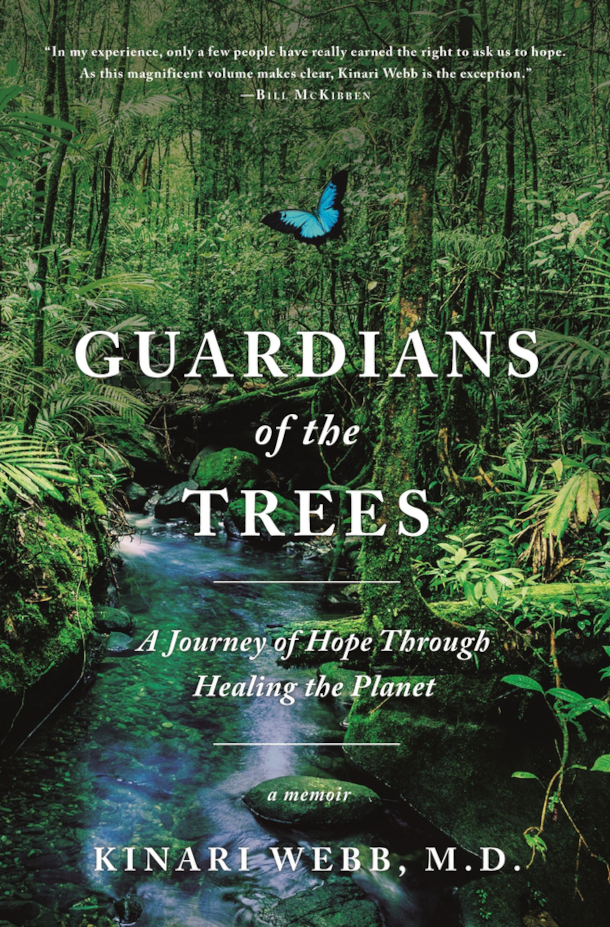
“Guardians of the Trees: A Journey of Hope Through Healing the Planet: A Memoir” reflects on the connections between human health and planetary health through the eyes of physician Kinari Webb as she treats patients in the rainforests of Indonesian Borneo. (Photo: Courtesy of Flatiron Books)
CURWOOD: It’s Living on Earth, I’m Steve Curwood.
BASCOMB: And I’m Bobby Bascomb
Gunung Palung National Park in Indonesian Borneo is home to hundreds of endemic species found nowhere else on earth; think orangutans, white bearded gibbons, and proboscis monkeys to name a few. And the rainforests of Borneo are vitally important both as a habitat and a sink to absorb and store climate warming carbon dioxide. Much of the soil in Borneo is peat bogs, one of the most carbon dense ecosystems on earth. Largely because of deforestation Indonesia often ranks in the top 10 for greenhouse gas emitting countries.
CURWOOD: Kinari Webb is a physician who first saw the deforestation in Indonesia when she was still a college student. Deeply troubled she asked local people what they needed to stop cutting the trees. And when they told her they needed medical care Kinari changed her life. She came home to the US, eventually went to medical school and completed a family practice residency before heading back to the rainforest to listen again to the people there and learn how she could best provide high quality health services. Her memoir, Guardians of the Trees: A Journey of Hope Through Healing the Planet explores her challenges and successes in Borneo. Doctor Webb joined Bobby and me for a Living on Earth Book Club live event at the Harvard TH Chan School of Public Health to tell her story.
WEBB: So when I first went to Borneo to study orangutans, I was just so angry at the local community members who were cutting down these giant rainforest trees, which might even be 1000 years old. And I just thought, how can they do this? Don't they know that the forest is also important for their own future wellbeing, and not just the future wellbeing of the whole planet? But then I got to know many of them and it just broke my heart when I realized what they told me was going on is that they were often forced to log to pay for health care. And that just shouldn't be. And why do these communities have so few resources? Because of many 100 years of colonialism, right? So what I like try to explain to people here in the US often, is your wellbeing is actually dependent on the wellbeing of people living around rainforests. And when they're also forced to invade into forest, you have a higher chance of spillover for pandemics. You know, this is not the only problem for loss. Of course, of course, we also have companies cutting down large amounts of forests. But this problem of local communities wanting to protect the forest and not able to, is a serious problem in many, many places. And it's often access to health care. Right? One woman told me if anyone tells you that they have not logged to pay for health care, they are lying to you, because that is the only way to get enough money for a medical emergency, which can cost an entire year's income.
CURWOOD: So I take it this is your inspiration for starting the group Health In Harmony.
WEBB: Yeah.
CURWOOD: And you say at one point this is a divine calling, this work.
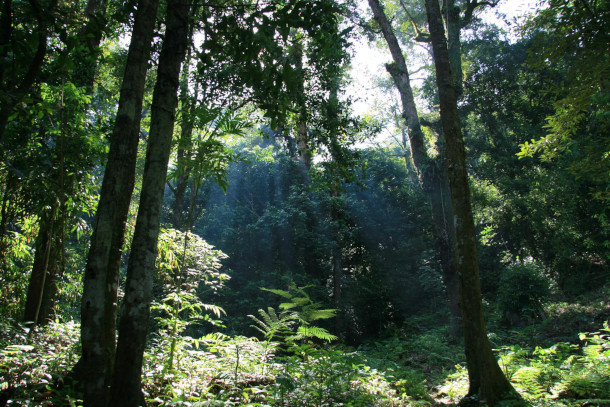
Gunung Palung National Park is the unfortunate target of illegal logging, often by locals who resort to such measures to pay for healthcare costs. (Photo: Tom, Wikimedia Commons, CC BY-SA 2.0)
WEBB: Yeah, it is. It is, I'll tell you, this book is also a divine calling. And if I didn't have to do it, I wouldn't, I would much rather not have released this book. But we don't have time. And this is the great period of time, in probably all of human history. We either make this enormous change, where we recognize that we are all interrelated and that we will not survive without each other. And when I use the word all, I mean it in the way that many indigenous communities use it. Whereas our cousins, the trees and the animals, right? We are all interrelated. And we can't survive without our lungs and our heart. And it's like, we can't survive. And we can't survive if some people are suffering, because of a long history of colonialism, resources need to flow back. And these communities know what the solutions are. They know how to solve the problems, how to address the critical, I call them fulcrums of change. These areas where if you change those few things, and I think they're completely invisible to outsiders, but local communities can say if these things change, everything else will change.
BASCOMB; Well, that's certainly true. Can you tell our listeners some of the details of how it works? How do you provide health care to people in exchange for not logging? What were some of the details that you've worked out with them? Or really that they suggested to you?
WEBB: Yeah, so some of the cool things are, they wanted affordable, high quality health care, Okay, so affordable, how do we make it affordable? Well, we could just provide it for free. But then they said if they was free, they wouldn't value it as much. But we want everyone who can, no matter how poor they are to be able to pay for it. So the way that we did it was everyone can pay with non cash payment options, and you can pay with seedlings. And if a given community is not logging at all, they get a greater thanks from the world community. So they get a 70% discount on their health care costs. So they have to pay with fewer seedlings. If their community is logging, they have to pay with a little bit more seedlings. But they love this because they see this direct connection. And it helps them encourage the few folks who are continuing to log to stop. And then they asked for alternative livelihoods in organic farming training. So that's also, you can also in our clinic pay for your health care with manure, we use that manure for the for the organic farming training. So there's always this, you can see very clearly how the health of the natural ecosystem and the health of the economic system is fully related to the health of people. Which is true, right? That's just true. And it tends to be the way that rainforest communities see it, right, this everything is interconnected. But in the West, we tend to be very siloed. We think healthcare is somehow separate from the environment and somehow separate from economic well being. But of course it isn't.
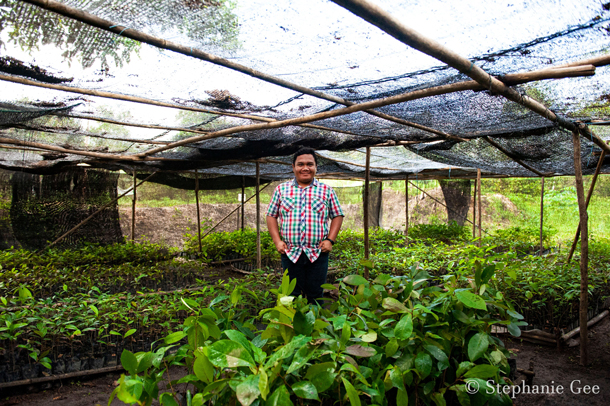
Health in Harmony is part of the nonprofit ASRI founded by Dr. Webb which also has a location on Java Island in Indonesia. Here, ASRI’s Director of Conservation Programs, Dika, stands in a seedling nursery. (Photo: Stephanie Gee)
BASCOMB: That's really profound. And I think you really do have such a wonderful model here for other countries and other communities to emulate. Can you talk about, you know, maybe the personal story of one of the people that came into your clinic that you were able to help? I'm thinking of a patient named Dardi. Can you tell his story for us?
WEBB: Sometimes I think about his story as a metaphor for where we all are on the planet. Dardi, his mother found us at an eyeglass distribution center, when we were giving out eyeglasses one day, and she must have run long distance to come and find us. And she's "please, please come see my son". So we went to go see her son, she has a tiny little house very, very small. And within that space, she had created this sort of even tinier little room that was completely dark. And he had been in that dark room for eight years, suffering in horrible, excruciating pain in his head. He was also incontinent, although his mother kept him exquisitely clean. And he couldn't tolerate any noise, he couldn't tolerate any light. And it turned out that he had tuberculosis of his brain. And probably had like a tuberculoma, which is a kind of a massive tuberculosis in his brain. So he was in just terrible distress, suffering extremely. She had spent every bit of money they possibly had on care and had not been able to figure out what was wrong with him. We were able to correctly diagnose him and start him on treatment. He was, in fact, our first inpatient at the clinic when we started. And that was like, it was kind of a, this totally miraculous thing. We had to like, bring him at night, and like, you know, put all shades, nearly carry him into the clinic. And then we were able to give him antibiotics, that tuberculosis medicines and also some steroids to kind of prevent any, as all the TB bacteria are dying, they can create a lot of inflammation. So we were able to treat him. Within two days, he is like, like walking, he can tolerate light. I mean, it was, just the improvement was just unbelievably dramatic. And his mother paid with non-cash payments, she went paid with these beautiful handicrafts that she had made. But the thing about TB medicines, you have to take them for a very long time. Because even though you have this dramatic improvement right away, you really have to take your medicines. So that was a whole nother process. But then, even though he eventually was better, physically, he was terrified. He was terrified to go outside, after being in the dark for so long. You know, it makes sense that you would just be scared, right? It's a totally new thing out there. And so then we had to have a psychiatrist come and work with our Indonesian docs to teach them how to help him, slowly learn how to be in the world. And that did work. And then one day, he actually asked Dr. Made, who was the doctor is taking care of him, can I go to the beach. And for me, that is kind of like, that's where we are on this planet, right? We have been in the dark for a very long time. We are just beginning to see our interconnections. We are just beginning to see what a massive crisis climate change is. But now we're scared. Even though the truth, the healing knowledge of truth is basically here from almost all of us. We don't know what to do. We don't know how to be in the world. And there is that personal healing and that community healing that leads to the planetary healing. And eventually Dardi actually got a job and he was able to support his family. And, you know, he had this integrated health in all ways, with a healthy sustainable livelihood, and a sustainable family, and he could have access to continued care. That's what we need to do on our planet. We need to do the personal healing, and the community healing and the global healing. And we need to listen to those who have suffered the most about what the solutions are.
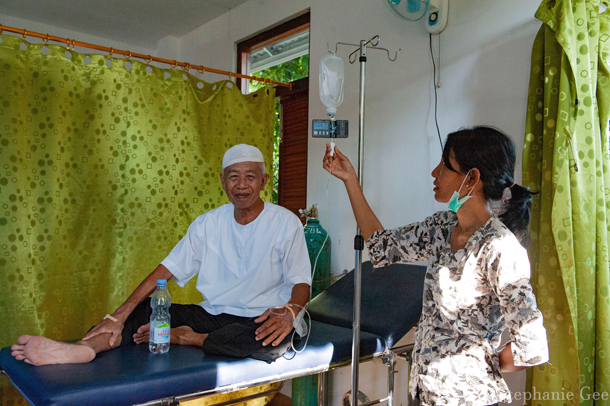
A patient is treated at the ASRI medical clinic. (Photo: Stephanie Gee)
BASCOMB: It seems a tall order, but you've really given us a path forward, I think, with this book and the beautiful stories within it.
WEBB: We're also working on a platform to really help people connect around the world, where people can see the solutions of rainforest communities and then be able to partner with them. And yeah, bring about this great healing.
BASCOMB: Before you really got going with your clinic and the reforestation efforts there, you engaged in something you called radical listening. You know, the notion that you want the members of the community, you want to go and ask them what they need and then listen to them. And that was sort of a radical approach to this type of work. Can you tell us a little bit about why is that a radical notion? Why isn't that done more often?
WEBB: Yeah, well, you wouldn't think it'd be radical, right? I mean, I always kind of joke like, like, the really radical thing is that we don't only listen to communities about the solutions are, we actually do it, right? Because lots of organizations say they listen, or they get input about what their idea is. That's, that's a common way of doing it as well, which from my perspective, is not radical listening. Radical listening is to let go of your own control of what the answer is. To say, I trust you, I trust the local knowledge that you know what the best solutions are. And then I will absolutely bring resources from the global north, and exactly execute your solutions. It's radical also, because it is a reversal of the colonial flow of resources. And it's not just like one and done. It's a constant process of like working with the communities. Okay. So how's this going? Now, do we want adjusted in any way? And how that's going? And what is, and it's not just like the biggest part of the solutions, but every detail of the solutions as well.
CURWOOD: So I want to follow up with a question because, I mean, you've had such remarkable results in Borneo. And the question is, how might these be replicated in other forest communities, the Amazon or the Congo and wanted to know, particularly about your experience in the Brazilian part of the Amazon, especially during this pandemic?
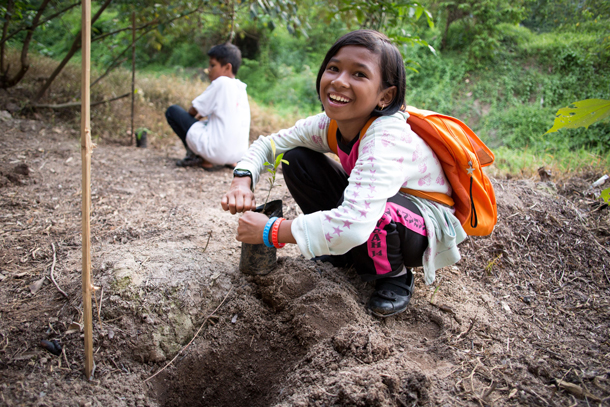
A young girl plants a seedling at the ASRI clinic in Gunung Palung National Park in Indonesian Borneo. (Photo: Chelsea Call)
WEBB: Yeah. So we have known we needed to move really fast. And we knew we had a model which looked like it was working in Borneo. It was very, Stanford did an evaluation, it looked very, very successful. The data is excellent. But we wanted to see if it would work in ecosystems that were very different. So we started working in Madagascar. Actually, Emerson, who's our fabulous program director, she says, if we can be successful in Madagascar, we were very successful anywhere in the world, because there are so many stressors, and it's very, very difficult to work there. But we have so far been wildly successful. And again, with radical listening, the communities are identifying healthcare, alternative livelihoods and education access as the key factors. And again, in Madagascar, the threat to the forest is primarily individuals who want to protect the forest, but just don't have a choice. And see that they are making a choice between their short term well being and their long term well being. But what are you going to do, right? I mean, if I had to cut down trees to pay for a C section, I would do it, right? Of course I would. It's a little different in the Amazon, what you have are rainforest communities, indigenous communities, other traditional communities, like descendants of rubber tappers, who are living in the forest and protecting it and protecting it from invaders. But when they get sick, and die, or when they have to leave to access services, they leave forest vulnerable to be invaded by outsiders, to be cut down. And occasionally they will make deals. There's one man we know of who had worked his entire life to protect the forest. And then his son got really sick and was going to need long term care. And he made a deal with a logging company who came in, right and they paid him enough that it would be, he would be able to take care of his son, and how can you blame him? And yet, I don't want anyone to ever have to make that decision. So we did radical listening again with these rainforest communities and asked them what they would need. What are the solutions that they see for protecting the forest? What do they need, we call it a thank you from the world community, so that they can protect this forest? And again, they needed access to health care, particularly during the pandemic. They needed the ability to be evacuated, if they were very sick. They needed vaccines. So we've been doing vaccine trips up, and they needed health care trips, like three or four times a year. And we've been doing that as well.
CURWOOD: How do you bring what you've learned with radical listening home to America? Because we have a society where instead of cutting down trees, people are burning or extracting fossil fuels, investing their retirement accounts in fossil fuels. So, how do you bring this concept of radical listening back to an America that is so broken right now seems like we don't listen to each other. We have nurses picketing hospitals protesting a vaccine mandate. I mean, man, it seems to me the folks in the rainforest are in a much better shape than we are right now.
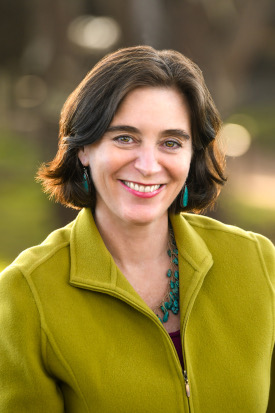
Kinari Webb MD is the founder of nonprofit Health in Harmony and the author of Guardians of the Trees: A Journey of Hope Through Healing the Planet: A Memoir. (Photo: Courtesy of Flatiron Books)
WEBB: Well, I think actually, many of the issues are very similar. First of all, there are social justice issues. Right? There's intersectional environmentalism, which is to say, where are the worst polluting industries? In communities of color, right? What are the solutions? Those who are closest to the problems are going to know the solutions the best. And I believe that should be on a neighborhood basis, which is to say every neighborhood is going to know what the solutions are for their neighborhood. And the way we do radical listening is people sit in a circle, everyone would know, what would you need as a thank you from the world community so that you could actually reduce your fossil fuel emissions? Right? I highly suspect that access to health care is actually one of those key fulcrums of change also, in this country. That if we had universal health care, I know many people would change their jobs, would choose livelihoods that were actually about thriving, right, thriving personally and thriving globally. But they often don't feel like they can even leave the jobs that they have because of access to health care. I don't know what the solutions would be. But I know who to ask. Right? And I know that communities could come up with solutions. And even imagine if we got discounts on our health care premiums, if we were emitting, you know, less fossil fuels, right, like, they should be connected, they are connected. So why not directly connect them? I bet it would work wonders.
CURWOOD: Dr. Kinari Webb is the founder of Health In Harmony and the author of Guardians of the Trees: A Journey of Hope Through Healing the Planet. And just say, Kinari, thanks so much for joining us.
BASCOMB: Thank you so much, and best of luck in the rest of the work that you're doing there.
WEBB: Thank you so much. It's such an honor.
Related links:
- Learn more about Kinari’s nonprofit, Health in Harmony
- Find the book "Guardians of the Trees" (Affiliate link helps donate to LOE and local indie bookstores)
- Watch the full recording of this Living on Earth Book Club live event
[MUSIC: Lotus, “The Monkey And The Moon” on Borneo]
CURWOOD: Living on Earth is produced by the World Media Foundation.
Our crew includes Naomi Arenberg, Paloma Beltran, Chloe Chen, Iris Chen, Josh Croom, Jenni Doering, Delaney Dryfoos, Mark Kausch, Mark Seth Lender, Don Lyman, Louis Mallison, Aynsley O’Neill, Sophia Pandelidis, Jake Rego, Hannah Richter, and Jolanda Omari.
Tom Tiger engineered our show.
Alison Lirish Dean composed our themes.
BASCOMB: You can hear us anytime at L-O-E dot org, Apple Podcasts and Google Podcasts, and like us, please, on our Facebook page - Living on Earth.
we tweet from @livingonearth. And find us on Instagram at livingonearthradio.
I’m Bobby Bascomb
CURWOOD: And I’m Steve Curwood, Thanks for listening!
ANNOUNCER: Funding for Living on Earth comes from you, our listeners, and from the University of Massachusetts, Boston, in association with its School for the Environment, developing the next generation of environmental leaders. And from the Grantham Foundation for the protection of the environment, supporting strategic communications and collaboration in solving the world’s most pressing environmental problems.
ANNOUNCER 2: PRX.
Living on Earth wants to hear from you!
Living on Earth
62 Calef Highway, Suite 212
Lee, NH 03861
Telephone: 617-287-4121
E-mail: comments@loe.org
Newsletter [Click here]
Donate to Living on Earth!
Living on Earth is an independent media program and relies entirely on contributions from listeners and institutions supporting public service. Please donate now to preserve an independent environmental voice.
NewsletterLiving on Earth offers a weekly delivery of the show's rundown to your mailbox. Sign up for our newsletter today!
 Sailors For The Sea: Be the change you want to sea.
Sailors For The Sea: Be the change you want to sea.
 The Grantham Foundation for the Protection of the Environment: Committed to protecting and improving the health of the global environment.
The Grantham Foundation for the Protection of the Environment: Committed to protecting and improving the health of the global environment.
 Contribute to Living on Earth and receive, as our gift to you, an archival print of one of Mark Seth Lender's extraordinary wildlife photographs. Follow the link to see Mark's current collection of photographs.
Contribute to Living on Earth and receive, as our gift to you, an archival print of one of Mark Seth Lender's extraordinary wildlife photographs. Follow the link to see Mark's current collection of photographs.
 Buy a signed copy of Mark Seth Lender's book Smeagull the Seagull & support Living on Earth
Buy a signed copy of Mark Seth Lender's book Smeagull the Seagull & support Living on Earth

